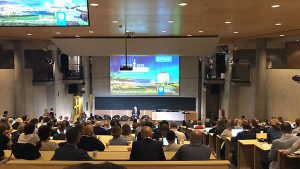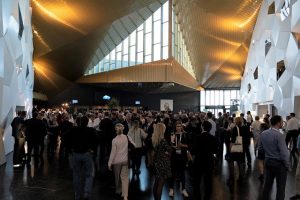With many colleges and universities considering expansion – new buildings, bigger spaces – they are increasingly turning to data analytics for their real estate needs. They are also considering how to balance the needs of a physical university with student demands for virtual learning.
I recently attended the European University Information Systems (EUNIS) 2019 Annual Congress in Norway, in which the discussion of university real estate featured prominently. Here are some of my takeaways from the event.
Keynote addresses the changing campus
The EUNIS conference was a fantastic experience that left me with many new ideas and great people with whom to connect and discuss education topics. One of the presentations that definitely stood out to me was the keynote by Alexandra den Heijer, from the faculty of Architecture at TU Delft. Apart from some nice photos of the place I live very close to, Alexandra gave a very insightful presentation on the development of university campuses and the way technology seems to progress in general.
Alexandra started by pointing out that around the year 2000, when email and internet came around, lots of people advocated for a university that is no longer a physical building, but would merely consist of IT-based technologies. People would simply follow classes, work together, and do everything they do on campus from any place with an internet connection. In essence, the Campus Manager would become the IT Manager. The major drivers for these changes (and almost any change, I would advocate) are user demand, cost, politics (such as university and city ambition or planning), and architecture or location (including energy-efficiency).

One of the things I found striking about Alexandra’s presentation was how she, very rightfully, pointed out that this change is not a black and white story. There are shades of gray between a fully internet-based university (or campus) and a traditional university with no technology around. She made the case for 3 types of campus:
- Traditional: The brick-and-mortar campus
- Virtual: A campus without any physical meeting space
- Networked: A mixture of the two
Three types of campus
A traditional campus is the campus that is a central place in the city. It is characterized by people who have their own territory (their own office, for example) and lots of physical space. They don’t move around much. This model has the advantage of providing a community feeling to the campus that is often filled with traditions and rituals. The problem with the traditional campus is that it is very expensive and it does not always allow everyone to attend lectures.
The virtual campus solves these problems: Having no buildings to maintain is a pretty good cost saver and having all lectures online also means that people with jobs or who may be living far away from campus can attend the university. This dramatically democratizes the university. The problem with this model is that people do not have a strong sense of belonging somewhere. It’s also hard to have a good work-life balance if there are no set hours to do work or study.
On top of that, some research has proven that students who attend online courses miss the urgency to actually finish their course and, though research findings are mixed, there is evidence at other universities that shows that students who follow digital courses instead of the physical courses have dramatically lower graduation rates.
The networked model seems to be a mix between these two. In this model, the campus functions as a marketplace of knowledge, a shared space where university workers, students, and even outsiders (like businesses) can meet and work together. The campus space is used by everyone.
According to Alexandra’s research, around 2006 most universities saw the virtual model as the end goal. Since 2016, the pendulum seems to have started swinging back in favor of the traditional model, or increasingly, the networked model. We can also see this in our own universities: Students can study and learn from anywhere, yet the lines for a place at the libraries are longer than ever. This mixed model of course causes new problems for universities. Shared learning spaces are often reserved by projects or groups of university workers (for example, via an app), but end up not being used at all.

Courtesy: EUNIS
Data provides insight
How do we efficiently manage the balance between physical and virtual? Which methods are most effective? How do we effectively manage cost against benefits? This obviously starts with insights through transparency.
Dimensional Insight Netherlands has recently started developing a real estate management tool. While not targeted at universities specifically, it can aid in projecting student growth at a school and how that can affect staffing needs, particularly when combined with our education quality monitor. One can gather and clean all data necessary to use as input for use in planning and resource allocation (including classroom sizes). The real estate management tool also helps institutions reduce the environmental impact their buildings and its users have.
If you’re interested in learning more, I highly recommend checking out the website of Alexandra den Heijer’s research group. It contains lots of interesting blog posts, a summary of the books the research group has written and all their publications. Really worth a look!
If you’re interested in getting involved in our development of a real estate management tool for your university, we are looking for partners to work together with and join us on this journey. The best way to get in touch is by contacting me directly via [email protected]. We’re looking forward to adding our value to this complex puzzle.




